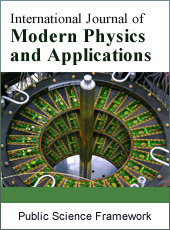International Journal of Modern Physics and Applications
Articles Information
International Journal of Modern Physics and Applications, Vol.6, No.1, Mar. 2020, Pub. Date: Mar. 2, 2020
Estimation of Interface Temperature During Contact Sliding
Pages: 1-8 Views: 1987 Downloads: 534
[01]
Md. Sabbir Hossain, Mechanical Engineering, Dhaka University of Engineering and Technology (DUET), Gazipur, Bangladesh.
[02]
Mohammed Salah Uddin, Mechanical Engineering, Dhaka University of Engineering and Technology (DUET), Gazipur, Bangladesh.
[03]
Abu Saleh Mohammed Oliullah, Mechanical Engineering, Dhaka University of Engineering and Technology (DUET), Gazipur, Bangladesh.
[04]
Md. Sadat Amin, Department of Electrical and Electronics Engineering, American International University-Bangladesh, Dhaka, Bangladesh.
[05]
Md. Tariqul Islam, Department of Electrical and Electronics Engineering, American International University-Bangladesh, Dhaka, Bangladesh.
[06]
Abdun Naqib Jimmy, Department of Environmental Science and Management, North South University, Dhaka, Bangladesh.
In machining operation, heat generated on the contact interface is important for the performance of the tool and quality of the finished product. The effect of the interface temperature, particularly when it is high, is mostly detrimental to both tool and work piece. The machining and tool life can be improved by the knowledge of interface temperature between tool and workpiece. In this mini project, the variation of different parameters on interface temperature is evaluated. An experiment is sated up to measure the interface temperature developed between grinding wheel and workpiece, during grinding operation in a surface grinding machine, under different parameters. The metal cutting parameters considered are feed rate and depth of cut with dry and wet condition. In this experiment, an assembly of k-type thermocouple and digital thermometer are used for measuring the temperature. The grinding wheel used is of silicon carbide and work pieces are 42CrMo4 Steel 16MnCr5 Steel plate. These steel work pieces are used because it have large variety of applications like worms, gears, machine parts, components of tool die set, tool holder etc. From the data collected during the experiment, the effects of different grinding parameters on temperature developed between grinding wheel and workpiece interface and suitable grinding conditions can be understood for obtaining maximum material removal rate at lower temperature. The obtained results are tabulated and analyzed graphically.
Interface Temperature, Contact Sliding, Flash Temperature, Temperature Measurement
[01]
Y. Takeuchi, M. Sakamoto, T. Sata, Improvement in the working accuracy of an NC lathe by compensating for thermal expansion, Precision Eng. 4 (1) 19–24.
[02]
Narayanan V., Krishnamurthy K., Hwang J., Madhavan V., Chandrasekar S., Farris T. N., http://roger.ecn.purdue.edu/~farrist/ Public_Papers/Machining%20 Komanduri.pdf.
[03]
R. Komanduri, Z. B. Hou (2001) A review of the experimental techniques for the measurement of heat and temperatures generated in some manufacturing processes and tribology. Mechanical and Aerospace Engineering, Oklahoma State University, Stillwater, OK 74078, USA
[04]
Kennedy FE. Surface temperatures in sliding systems — a finite element analysis. Trans ASME 1981; 90: 90–6.
[05]
Komanduri R. Machining and grinding — a historical review of classical papers. Applied Mechanics Reviews 1993; 46: 80–132
[06]
L. B. Abhang, M. Hameedullah,'Chip-Tool Interface Temperature Prediction Model for Turning Process', International Journal of Engineering Science and Technology, 2 (4), 2010, 382-393.
[07]
G. Barrow, ANN, CIRP 22, 203-211. 1973
[08]
Shaw, M. C, Metal cutting principles, Oxford University, press, Londan, 1984
[09]
D A Stephenson, Metal cutting theory and practice, chapter-7 cutting temperatures, (www.google.co.in) pp-415-419.
[10]
D. A. Stephenson, Tool –work thermocouple temperature measurements: theory and implementation issues, Proceedings of winter Annual meeting of ASME, Anaheim CA. November (1992), pp-18-95.
[11]
EI Wardany, T. I Mohammed, E, Elbestawi, M. A., Cutting temperature of ceramic tools in high speed machining of difficult to cut materials. Int. J. Mech Tools, Manuf. (1996), 36 (5), 611-634.
[12]
Lowen E. G. and Shaw M. C, on the analysis of cutting tool temperatures, Transactions of the ASME, 001. 76 pp-217-231, (1954).
[13]
P. K Wright, Correlation of tempering effects with temperature distribution in steel cutting tools, J. Eng. Ind. 100, 1978. 131-136.
[14]
Trigger, K. J. Progress report No. 1, on chip-tool interface temperature Trans. ASME, 70, pp-91-98, (1948).
[15]
Grzesik, W, Experimental investigation of the cutting temperature when turning with coated Index able inserts. Int. J, of Machine tools and manufacture, 39 pp 355-369, (1999).
[16]
O, Sullivan and Cotterm, Temperature measurement in single point turning, Journal of material processing technology vol. 118 pp. 301-308,(2001)
[17]
Tent, E M. and Wright, P. K. Metal cutting theory, forth edition, Butterworth- Heinwmann, Boston, MA, 2000.

ISSN Print: 2381-6945
ISSN Online: 2381-6953
Current Issue:
Vol. 7, Issue 1, March Submit a Manuscript Join Editorial Board Join Reviewer Team
ISSN Online: 2381-6953
Current Issue:
Vol. 7, Issue 1, March Submit a Manuscript Join Editorial Board Join Reviewer Team
| About This Journal |
| All Issues |
| Open Access |
| Indexing |
| Payment Information |
| Author Guidelines |
| Review Process |
| Publication Ethics |
| Editorial Board |
| Peer Reviewers |


